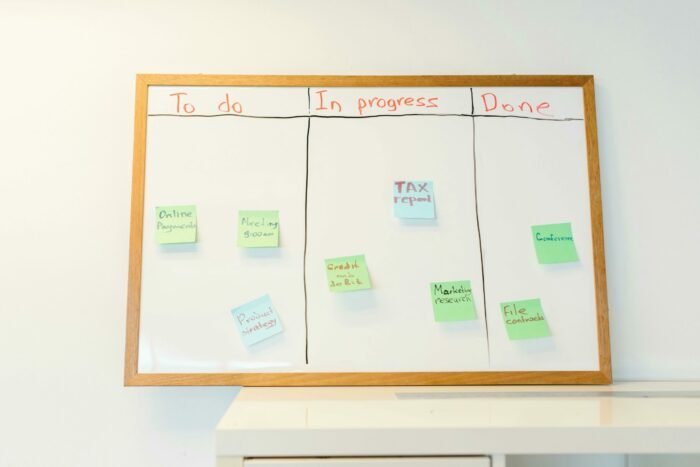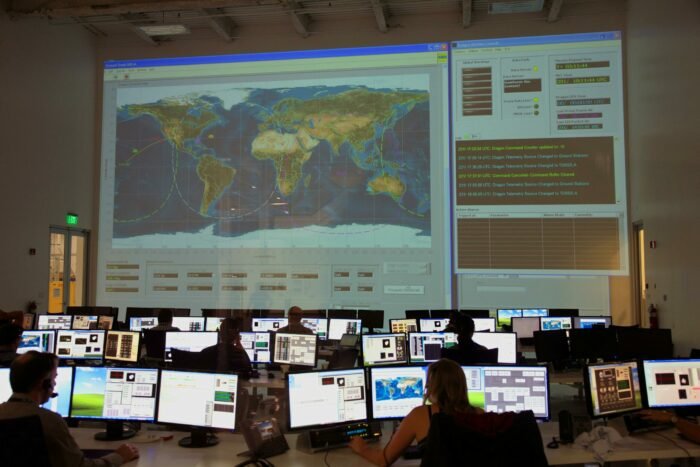Welcome to our guide on efficient project management canvases! In today’s fast-paced business environment, effective project management is crucial to ensure successful outcomes. Project canvases provide a visual and concise way to plan and communicate project details, enabling teams to stay organized and focused on achieving their goals.
Project management canvases are powerful tools that streamline the project planning process. They encompass various elements, such as purpose, scope, success criteria, actions, milestones, team, stakeholders, resources, constraints, and risks. By utilizing project management canvases, you can create a clear roadmap for your project, facilitate collaboration, and enhance decision-making.
Efficient Project Management Canvases Guide
Key Takeaways
- Project management canvases are one-page templates that provide a visual overview of a project.
- They simplify project communication and improve collaboration within project teams.
- Project management canvases can be used at different stages of a project, from kickstart to project management.
- Key elements of a project canvas include purpose, scope, success criteria, actions, team, stakeholders, resources, constraints, and risks.
- By utilizing project management canvases, you can enhance project planning and execution.
What is a Project?
A project is an individual or collaborative enterprise carefully planned to achieve a particular aim. It is a unique endeavor with specific end results. Projects typically have limited resources and involve inherent risks. Understanding the characteristics of a project is crucial for effective project management.
Projects are defined by their:
- Purpose: The specific aim or objective that the project aims to achieve.
- Scope: The boundaries of the project, including what is included and excluded.
- Resources: The physical, financial, and human assets required to complete the project.
- Constraints: The limitations or restrictions that impact the project’s execution, such as budget, time, or regulations.
- Risks: Uncertainties that may arise during the project and have the potential to impact its success.
“A project is like a journey with a defined destination, limited resources, and possible detours along the way.”
Project characteristics provide a framework for project managers to understand and navigate the complexities of their projects. They help in setting realistic expectations, allocating resources efficiently, and mitigating risks.
| Project Definition | Project Characteristics |
|---|---|
| An individual or collaborative enterprise carefully planned to achieve a particular aim. |
|
Understanding the nature of a project enables project managers to develop appropriate strategies, allocate resources effectively, and mitigate potential risks. By embracing the specific characteristics of a project, teams can work together to achieve successful outcomes.
Purpose and Scope
When starting a project, it’s essential to have a clear understanding of why it is being initiated and what outcomes are desired. The purpose of a project serves as the fundamental reason behind its execution, guiding the team towards a shared goal. By unifying our understanding of the project’s purpose, we can align our efforts and work collaboratively towards achieving success.
Furthermore, defining the scope of a project is equally important. The scope outlines what is included and excluded from the project, setting boundaries and providing clarity on the work that needs to be done. It serves as a reference point for understanding the workload, managing expectations, and ensuring that the project stays focused and on track.
Understanding the purpose and scope of a project is pivotal to its success. It enables us to establish a common vision, set realistic goals, and effectively manage the project’s progress.
Project Purpose
The project purpose defines the why behind the project. It articulates the overall objective and the desired outcomes that the project aims to achieve. Having a clear project purpose helps motivate the team and ensures that everyone is working towards a common goal.
Project Scope
The project scope defines the boundaries or extent of the project. It outlines what is included and excluded from the project, specifying the deliverables, features, and functionalities that will be developed. The scope serves as a reference point for project planning, resource allocation, and controlling project changes.
By clearly defining the project purpose and scope, we can set the foundation for a successful project. It allows us to prioritize tasks, allocate resources effectively, and manage stakeholders’ expectations.
| Project Purpose | Project Scope |
|---|---|
| Defines the overall objective and desired outcomes of the project. | Specifies what is included and excluded from the project, providing boundaries and setting expectations. |
| Helps unify the team’s understanding and motivation. | Serves as a reference point for project planning and resource allocation. |
| Guides decision-making and ensures alignment with project goals. | Controls project changes and mitigates scope creep. |
Success Criteria and Actions
In order to measure the success of a project, it is essential to establish clear success criteria. These criteria serve as benchmarks for evaluating whether the project objectives have been achieved satisfactorily.
Success criteria define the specific outcomes or deliverables that signify project success. They provide a tangible way to assess progress and provide a target for the project team to aim for. By defining success criteria from the outset, we can ensure that everyone involved in the project is aligned and working towards the same goals.
“Success criteria are the compass that guides us through the project journey, helping us stay focused on what really matters and ensuring that our efforts are leading us in the right direction.”
In addition to defining success criteria, identifying and implementing the necessary actions is crucial to project success. Actions refer to the specific activities or tasks that need to be executed in order to reach project milestones and deliver the desired outcomes.
The actions can be categorized into different phases or stages of the project, and they should align with the project plan and timeline. By clearly defining and prioritizing actions, we can ensure that the project progresses smoothly and efficiently. Regular monitoring and tracking of actions is essential to stay on track and address any potential issues or roadblocks that may arise.
Let’s take a look at an example to better understand how success criteria and actions are interconnected:
| Success Criteria | Actions |
|---|---|
| Decrease customer support response time by 50% |
|
By defining success criteria and taking the necessary actions to achieve them, we set ourselves up for project success. It is important to regularly assess and review these criteria and actions throughout the project lifecycle to ensure they remain relevant and aligned with the project’s evolving needs.
Team and Stakeholders
Building a strong project team and effectively managing project stakeholders are crucial elements for the success of any project. The project team consists of individuals who bring their unique skills and expertise to accomplish project objectives. Each team member has specific roles and responsibilities that contribute to the overall project progress and outcomes.
Stakeholders, on the other hand, are individuals or groups who have a vested interest in the project’s success. They play various roles throughout the project lifecycle, such as providing guidance, resources, and support. It is essential to identify and engage stakeholders early on to ensure their needs and expectations are addressed.
By fostering collaboration and clear communication within the project team and effectively managing stakeholder relationships, project managers can create a positive and productive environment. This promotes teamwork, minimizes conflicts, and enhances overall project performance.
Project Team
Let’s take a closer look at the key project team roles and responsibilities:
| Role | Responsibilities |
|---|---|
| Project Manager | – Setting project goals and objectives – Planning, organizing, and directing project activities – Monitoring project progress and managing risks – Ensuring timely delivery and quality output |
| Team Members | – Contributing specialized skills and expertise – Collaborating with team members – Implementing project tasks and activities – Reporting progress and addressing challenges |
| Project Sponsor | – Providing strategic direction and resources – Advocating for the project – Approving project deliverables and changes – Ensuring project alignment with organizational objectives |
Project Stakeholders
Now, let’s explore the different types of project stakeholders and their involvement in the project:
- Internal Stakeholders:
- Executive Leadership: Provides guidance and support
- Functional Managers: Offers resources and expertise
- Project Team: Contributes to project delivery
- External Stakeholders:
- Customers and Clients: Receives project deliverables
- Suppliers and Vendors: Provides necessary resources
- Regulatory Agencies: Ensures compliance with regulations
- Community and Public: Impacted by the project outcomes
By involving stakeholders early and throughout the project, project managers can gain valuable insights and ensure alignment with their expectations. This proactive approach minimizes the risk of miscommunication, enhances stakeholder satisfaction, and increases the chances of project success.
Resources and Risks
In any project, the availability of adequate resources is vital for successful execution. Resources encompass physical assets, financial allocations, and the human capital necessary to accomplish project objectives. It is essential to identify and allocate these resources efficiently to ensure smooth project progression and desired outcomes.
Project constraints play a crucial role in project management, highlighting the known limitations that might impact project execution. Common constraints include budgetary restrictions, time limitations, and availability of skilled personnel. By acknowledging these constraints upfront, project managers can proactively plan and manage project activities to mitigate any potential adverse effects.
Project risks, on the other hand, represent uncertainties that may arise during the project lifecycle. These risks can severely impact project success if not properly identified, assessed, and managed. By implementing effective risk management strategies, project teams can proactively address potential obstacles and formulate contingency plans. This proactive approach ensures that risks are mitigated, minimizing their impact on project outcomes.
Allocation of Project Resources
Efficient allocation of project resources involves carefully assessing the needs of the project and identifying the necessary physical, financial, and human assets. This process allows project managers to effectively plan and utilize available resources for optimal project outcomes. By allocating resources based on project requirements, organizations can enhance productivity, reduce waste, and achieve project goals within the defined constraints.
Identification and Assessment of Project Risks
Identifying and assessing project risks is a critical aspect of project management. By proactively identifying potential risks, project teams can develop risk mitigation strategies and contingency plans to minimize their impact. Regular risk assessments and monitoring help in identifying new risks that may arise during the project lifecycle, allowing project managers to make informed decisions and take appropriate actions to address them.
| Project Resources | Project Constraints | Project Risks |
|---|---|---|
| Physical assets | Budgetary restrictions | Uncertainties in technology implementation |
| Financial allocations | Time limitations | Change in project requirements |
| Human capital | Availability of skilled personnel | Failure in vendor deliverables |
Effective management of project resources, constraints, and risks is crucial for successful project delivery. By considering these factors and adopting appropriate strategies, project managers can enhance project efficiency and mitigate potential obstacles, ensuring project success.
Conclusion
Project management is essential for successful project execution, and adopting the right tools and practices can greatly enhance project outcomes. The Project Canvas offers a simplified and efficient approach to project management, enabling teams to effectively communicate and collaborate.
By focusing on key elements such as purpose, scope, success criteria, and actions, project teams can gain a clear understanding of the project’s objectives and align their efforts towards achieving them. This visual overview provides a shared project understanding and enables decision-making based on a common framework.
However, to further enhance project success, it is important to follow project management best practices, leverage proven methodologies, and utilize comprehensive frameworks. These resources provide guidance on project planning, execution, and control, ensuring that projects are delivered on time, within budget, and meet or exceed stakeholders’ expectations.
From agile methodologies like Scrum and Kanban to traditional frameworks like Waterfall, there are various project management methodologies and frameworks available. Each has its strengths and weaknesses, and project managers should choose the most suitable one based on the project’s nature, organizational context, and team dynamics.
FAQ
What is a project canvas?
A project canvas is a one-page template that simplifies project communication and provides a visual overview of a project. It consists of 12 elements, including purpose, scope, success criteria, actions, milestones, team, stakeholders, users, resources, constraints, and risks.
How can a project canvas improve project management?
A project canvas improves project management by enhancing communication within project teams and providing a clear visual representation of the project. It can be used in various stages of a project, such as project kickstart, project overview, and project management.
What is the purpose of a project?
The purpose of a project describes why it is started and the desired outcomes. It provides the fundamental reason for initiating the project and helps unify the team’s understanding.
What does the scope of a project define?
The scope of a project defines what it includes and excludes. It serves as a reference point for the workload and helps manage expectations.
How do success criteria contribute to project management?
Success criteria indicate when the project purpose has been accomplished with a satisfactory result. They help evaluate the project’s progress and ensure that the desired objectives are achieved.
What are actions in a project canvas?
Actions refer to the activities that need to be executed to reach project milestones and deliver the desired outcomes. They provide a roadmap for project execution.
Why are the team and stakeholders important in project management?
The team members involved in a project and their roles are crucial for its success. Stakeholders are individuals or groups who have an interest in the project’s success and are involved in various capacities. Building an effective team and managing stakeholders are important aspects of project management.
What are resources and constraints in a project?
Resources are the physical, financial, and human assets required for the project. Constraints refer to the known limitations of the project, such as budget and time. Identifying and managing resources and constraints are essential for project success.
How do you handle project risks?
Risks are uncertainties that may occur during the project and need to be identified, assessed, and managed effectively. Project risk management involves strategies and techniques to mitigate potential risks and ensure project success.
How can project management best practices and methodologies enhance project success?
Following project management best practices and utilizing project management methodologies and frameworks can further enhance project success. These practices and methodologies provide a structured approach to project management and help teams achieve their project objectives more effectively.










